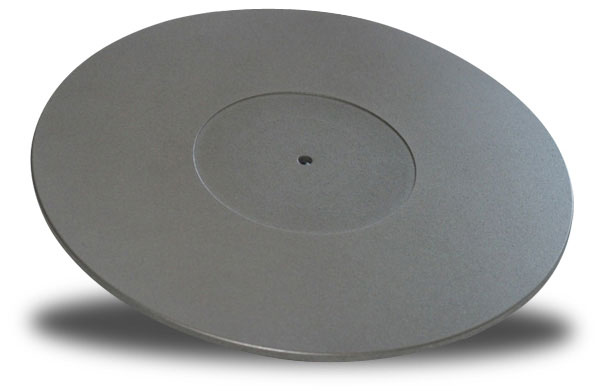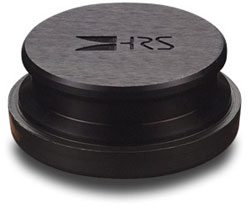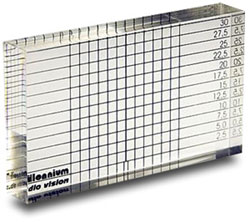July 9, 2008
Pimp Your Turntable
I ended my review of the
Boston Audio Mat 1 by revealing that "Boston Audio is working on a thicker, better Mat 2." I went on:
"Until [the Mat 2 is] available, the Mat 1 will be holding a place for it on my
turntable." Well, that time has come -- the Mat 2 ($279) is here and obviously
thicker: 5mm versus 3mm for the Mat 1 ($199). Using it with your turntable requires more
than simply plopping it on top of the platter. Its thickness will throw the vertical
tracking angle (VTA) off, and because it raises the record surface you'll also want to
measure and set the vertical tracking force (VTF) again. Unless you have a tonearm like
the Graham Phantom, whose center of gravity is at the 'arm's pivot point, the higher up
the record is, the greater any given setting of VTF will be. This is why it's vitally
important to measure tracking force at the record height. I adhere to this even with my
Phantom.
Austin Jackson at Boston Audio sees the Mat 2 as
an upgrade for mass-loaded turntables, and they don't get much more mass-loaded than my
TW-Acustic Raven AC, which weighs in at over 100 pounds. Like the Mat 1, the Mat 2 is
machined from a chunk of pure carbon graphite. Its surface is highly polished and sprayed
with four coats of a proprietary sealant. Boston Audio sculpts out an area for the label
and slightly rounds the outer edge, giving the Mat 2 a clean, finished look.

What's flat and round and gray all over? The Boston
Audio Mat 2 ($279).
"Focused" and "neutral" are
the words I used to describe the sonic effect of the Mat 1, and the Mat 2 increases these
to the point that it sounds distinctly better. It firms things up, anchoring musicians in
the soundfield and sharpening their placement in relation to each other. I suspect that it
accomplishes this by draining off stray resonance created by the stylus dragging through
the groove and by further isolating the record from vibration coming from the 'table's
bearing. The Mat 2 doesn't skew tonality, warming up or cooling off the sound. It lets the
glory of the vinyl speak for itself, and if you're listening to LPs that's exactly what
you want.
If your turntable is a heavyweight like the Raven
AC, you'll want to try the Mat 2 without delay. If you're using a rubberized mat whose
main value is its damping properties, get ready for a striking change -- the Mat 2 will
pep up the sound of your 'table.
 I've been using Harmonic Resolution Systems' finely
made Analog Disk LP clamp/weight ($210) with the Mat 2, and it's equally effective. A
machined-aluminum puck with a pad made of a proprietary soft polymer, the Analog Disk not
only applies some weight to the record but also grips the spindle, holding the record to
the platter mat. There's also a mild vacuum effect; when I push the Analog Disk down, it
forces air from underneath the record, which stays sucked down to the Mat 2. The Analog
Disk's size, shape weight and fit around the spindle are all deliberate, which may be the
reason the Analog Disk works so well -- lessening groove noise, sharpening transient
attack and improving retrieval of musical detail. The polymer is very effective at damping
the spindle, thereby reducing or eliminating any noise caused by the bearing.
I've been using Harmonic Resolution Systems' finely
made Analog Disk LP clamp/weight ($210) with the Mat 2, and it's equally effective. A
machined-aluminum puck with a pad made of a proprietary soft polymer, the Analog Disk not
only applies some weight to the record but also grips the spindle, holding the record to
the platter mat. There's also a mild vacuum effect; when I push the Analog Disk down, it
forces air from underneath the record, which stays sucked down to the Mat 2. The Analog
Disk's size, shape weight and fit around the spindle are all deliberate, which may be the
reason the Analog Disk works so well -- lessening groove noise, sharpening transient
attack and improving retrieval of musical detail. The polymer is very effective at damping
the spindle, thereby reducing or eliminating any noise caused by the bearing.
In the directions for the Analog Disk, HRS points
out in a circuitous way that its 3 1/4" diameter may mean that certain headshells
could rub against the Analog Disk when the stylus is at the end of the lead-out groove. I
was very concerned about this, as the headshell for the Graham Phantom is
oval-shaped and rather wide, but it clears without issue. I've actually tried to trip up
the Analog Disk, using it with as many headshells as I can to see if any of them scrape.
None has so far. Still, Harmonic Resolution Systems is being understandably cautious by
pointing this out in the unlikely event that it actually is an issue. From my
experience, it seems like it would be an exceedingly rare occurrence.
While squishy/rubberized record mats often
smother the life out of the music as they damp the deleterious effects of vibration and
resonance, I am still intrigued by the idea of a record mat made from HRS's special
polymer. For now, I'll use the Analog Disk on top of the record and leave what happens
underneath to the Boston Audio Mat 2. Neither product is outrageously expensive, and their
use together brings out the best in both.
 Finally,
a product that I don't use on my turntable but has become vital to dialing in its
highest performance. The Millennium
Audiotrade Acrylic Block V/H6035 ($74) may have a cryptic name, but it's very
straightforward to use in setting the vertical tracking angle (VTA) of the stylus. A
polished acrylic block measuring 3 3/8"W x 2 3/8"H x 7/16"D, it has
laser-cut lines that aid in leveling your tonearm to the record's surface, a point from
which you can go up or down and thereby tailor VTA to the stylus profile. Using the
Acrylic Block is a cinch. With your turntable off, put a record on the platter, move the
tonearm to the middle of the record and place the stylus onto the record surface. Put the
Acrylic Block in front of the tonearm. You'll be able to see right through it and use its
horizontal lines to level the tonearm.
Finally,
a product that I don't use on my turntable but has become vital to dialing in its
highest performance. The Millennium
Audiotrade Acrylic Block V/H6035 ($74) may have a cryptic name, but it's very
straightforward to use in setting the vertical tracking angle (VTA) of the stylus. A
polished acrylic block measuring 3 3/8"W x 2 3/8"H x 7/16"D, it has
laser-cut lines that aid in leveling your tonearm to the record's surface, a point from
which you can go up or down and thereby tailor VTA to the stylus profile. Using the
Acrylic Block is a cinch. With your turntable off, put a record on the platter, move the
tonearm to the middle of the record and place the stylus onto the record surface. Put the
Acrylic Block in front of the tonearm. You'll be able to see right through it and use its
horizontal lines to level the tonearm.
With 'arms like the Graham Phantom and the
Tri-Planar, the markings on the Acrylic Block, which are in 2.5mm increments, aren't as
useful for the purpose of determining exactly where your VTA is set as the markings on the
tonearms' own VTA-adjustment hardware. However, if you don't have an 'arm with any
markings, the Acrylic Block provides them, and for any tonearm with a non-tapered
armtube, the Acrylic Block makes setting level VTA quick and easy. While $74 for a piece
of acrylic is pricey, once you use the Acrylic Block you won't want to adjust VTA without
it.
...Marc Mickelson
marc@soundstage.com